ตำรามาตรฐานยาสมุนไพรไทย
Thai Herbal Pharmacopoeia
สำนักยาและวัตถุเสพติด กรมวิทยาศาสตร์การแพทย์ กระทรวงสาธารณสุข
Bureau of Drug and Narcotic, Department of Medical Sciences, Ministry of Public Health(Tinospora crispa (L.) Hook.f. & Thomson)
(Nelumbo nucifera Gaertn.)
(Centella asiatica (L.) Urb.)
(Centella Dry Extract)
(Centella Cream)
(Mesua ferrea L.)
(Piper sarmentosum Roxb.)
(Piper sarmentosum Roxb.)
(Pterocarpus santalinus L. f.)
(Santalum album L.)
(Senna tora (L.) Roxb.)
(Senna alata (L.) Roxb.)
(Senna Alata Tea)
(Piper retrofractum Vahl)
(Myristica fragrans Houtt)
(Andrographis paniculata (Burm. f.) Nees)
(Andrographis Capsules)
(Allium ascalonicum L.)
(Ocimum tenuiflorum L.)
(Curcuma longa L.)
(Turmeric Capsules)
(Turmeric Dry Extract)
(Turmeric Dry Extract Capsules)
(Arcangelisia flava (L.) Merr.)
(Curcuma sp.)
Harrisonia perforata (Blanco) Merr.
(Aristolochia pierrei Lecomte)
(Zingiber officinale Roscoe)
(Ginger Capsules)
(Ginger Tea)
(Cassia fistula L.)
(Nardostachys jatamansi (D. Don) DC.)
(Angelica sinensis (Oliv.) Diels)
Artemisia annua L.
(Ligusticum sinense Oliv. cv. Chuanxiong)
(Neopicrorhiza scrophulariiflora Pennell)
(Atractylodes lancea (Thunb.) DC.)
(Aucklandia lappa Decne)
(Terminalia chebula Retz.)
(Angelica dahurica (Hoffm.) Benth. & Hook. f. ex Franch. & Sav. var. dahurica)
(Kaempferia parviflora Wall. ex Baker)
(Hibiscus sabdariffa L.)
(Roselle Tea)
(Allium sativum L.)
(Zingiber zerumbet (L.) Sm.)
(Wurfbainia testacea (Ridl.) Škorničk.& A. D. Poulsen)
(Cannabis sativa L.)
(Myristica fragrans Houtt)
(Dracaena cochinchinensis (Lour.) S. C. Chen)
(Ficus racemosa L.)
(Hyptis suaveolens (L.) Poit.)
Clerodendrum indicum (L.) Kuntze
(Phyllanthus emblica L.)
(Citrus hystrix DC.)
(Citrus hystrix DC.)
(Areca catechu L.)
(Momordica charantia L.)
Moringa oleifera Lam.
(Aegle marmelos (L.) Corrêa)
(Solanum trilobatum L.)
(Morus alba L.)
Gynostemma pentaphyllum(Thunb.)
Makino
(Clinacanthus nutans (Burm. f.) Lindau)
(Cissus quadrangularis L.)
(Mimusops elengi L.)
(Zingiber montanum (J. König) Link. ex A. Dietr.)
(Piper betle L.)
(Capsicum annuum L.)
(Capsicum Oleoresin)
(Capsicum Gel)
(Piper nigrum L.)
(Piper nigrum L.)
(Eurycoma longifolia Jack)
(Thunbergia laurifolia Lindl.)
(Piper wallichii (Miq.) Hand.-Mazz.)
Senna garrettiana (Craib) H. S. Irwin & Barneby
(Terminalia bellirica (Gaertn.) Roxb.)
(Terminalia chebula Retz.)
(Caesalpinia bonduc (L.) H. Roxb.)
(Tarlmounia elliptica (DC.) H. Rob., S. C. Keeley, Skvaria & R. Chan)
(Hog Creeper Vine Dry Extract Capsiles)
(Hog Creeper Vine Dry Extract)
(Brachypterum scandens (Roxb.) Miq.)
(Lepidium sativum L.)
(Nigella sativa L.)
(Cuminum cyminum L.)
(Foeniculum vulgare Mill.)
(Plantago ovata Forssk.)
(Pimpinella anisum L.)
(Carum carvi L.)
(Anethum graveolens L.)
(Trachyspermum ammi (L.) Sprague)
Albizia procera (Roxb.) Benth.
(Acorus calamus L.)
(Tiliacora triandra (Colebr.) Diels)
Cyanthillium cinereum (L.) H. Rob.
(Orthosiphon aristatus (Blume) Miq.)
Murdannia loriformis (Hassk.) R. S. Rao & Kammathy
(Capparis micracantha DC.)
(Chrysopogon zizanioides (L.) Roberty)
(Cyperus rotundus L.)
(Cannabis sativa L.)
(Syzygium aromaticum (L.) Merr. & L. M. Perry)
(Boesenbergia rotunda (L.) Mansf.)
(Acanthus ebracteatus Vahl)
(Acanthus ilicifolius L.)
(Kaempferia galanga L.)
(Curcuma comosa Roxb.)
Betula alnoides Buch.-Ham. ex D. Don
Cannabis sativa L.
Carthamus tinctorius L
Mitragyna speciosa (Korth.) Havil
Mallotus repandus (Rottler) Müll. Arg
Azadirachta indica A. Juss. var. siamensis Valeton
Azadirachta indica A. Juss. var. siamensis Valeton
Punica granatum L.
Rhinacanthus nasutus (L.) Kurz
Baliospermum solanifolium (Burm.) Suresh
Curcuma aeruginosa Roxb
Boesenbergia kingii Mood & L. M. Prince
Senegalia rugata (Lam.) Britton & Rose
Acacia concinna (Willd.) DC.
Senegalia rugata (Lam.) Britton & Rose
Acacia concinna (Willd.) DC.
Senna alexandriana Mill. var. alexandriana
Cassia acutifolia Delile, Cassia angustifolia Vahl
Butea superba Roxb. ex Willd.
[Plaso superba (Roxb. ex Willd.) Kuntze, Rudolphia superba (Roxb. ex Willd.) Poir.
Pueraria candollei Graham
ex Benth. var. mirifica (Airy Shaw & Suvat.) Niyomdham
Streblus asper Lour.
Suregada multiflora (A. Juss.) Baill. (Gelonium
multiflorum A. Juss.
Blue Thunbergia Leaf is the dried leaf of Thunbergia laurifolia Lindl. (Family Acanthaceae), Herbarium Specimen Number: BKF 160078, Crude Drug Number: DMSc 0688.
Constituents Blue Thunbergia Leaf contains caffeic acid, flavonoids, sterols, etc.
Description of the plant (Figs. 1a, 1b) Climber to woody climber; s tem terete, glabrous to glabrescent. Leaves simple, opposite, oblong to ovate, 5 to 19 cm long, 2.5 to 9 cm wide, apex acute to acuminate, base cuneate, obtuse, truncate, or subcordate, margin entire or slightly crenate to dentate, basal veins 3 to 5, prominent on lower surface, both surfaces scabrous, glabrous or sparsely hispidulous, dark green above, lighter green beneath; petiole 1.5 to 6 cm long, sparsely hispidulous to nearly glabrous. Inflorescence pendulous, axillary or terminal raceme, 4 to 30 cm long; pedicel 1.5 to 3 cm long; bracteoles 2, ovate-lanceolate, 2 to 4.5 cm long, 1 to 2 cm wide, apex obtuse to acute, green with violet blotches. Flower blue to violet, showy, 6 to 8 cm in diameter; calyx green, 3 mm long, puberulous; corolla broadly funnelform, lobes 5, 3 to 4.5 cm long; s tamens 4, didynamous, filaments puberulous; ovary superior, 2-loculed, each with 2 axile ovules, s tyle 1, s tigma 2-lobed. Fruit capsule, subglobose at base, about 1.5 cm long, about 1.0 cm wide, with a s tout beak of 2 cm long at the tip, splitting through the beak into 2 pieces. Seeds 1 or 2 per locule, plano-convex, about 1 cm in diameter.
Description Odour, mild; taste, bland.
Macroscopical (Fig. 1a) A mixture of entire and broken, brown to dark brown, oblong to ovate leaves.
Microscopical (Figs. 2a, 2b, 2c) Transverse sections of the leaf through the midrib and the lamina show upper epidermis, a layer of elongated rectangular cells, irregular and wavy-walled in surface view; diacytic stomata; glandular trichome, unicellular stalk, 2-celled head; non-glandular trichome, unicellular. Lower epidermis, wavy-walled in surface view; diacytic stomata, numerous; glandular trichome, a few. Mesophyll, 2 or 3 layers of columnar palisade cells and several layers of irregular spongy cells. Underneath both epidermises, few layers of collenchyma cells associated with vascular tissues in the midrib. Vascular bundle, phloem in the upper part and xylem in the lower part, surrounded by bundle sheaths. Some bundle sheaths and parenchyma cells containing acicular crystals. Vessels, spiral, reticulate and pitted.
Blue Thunbergia Leaf in powder possesses the diagnostic microscopical characters of the unground drug.
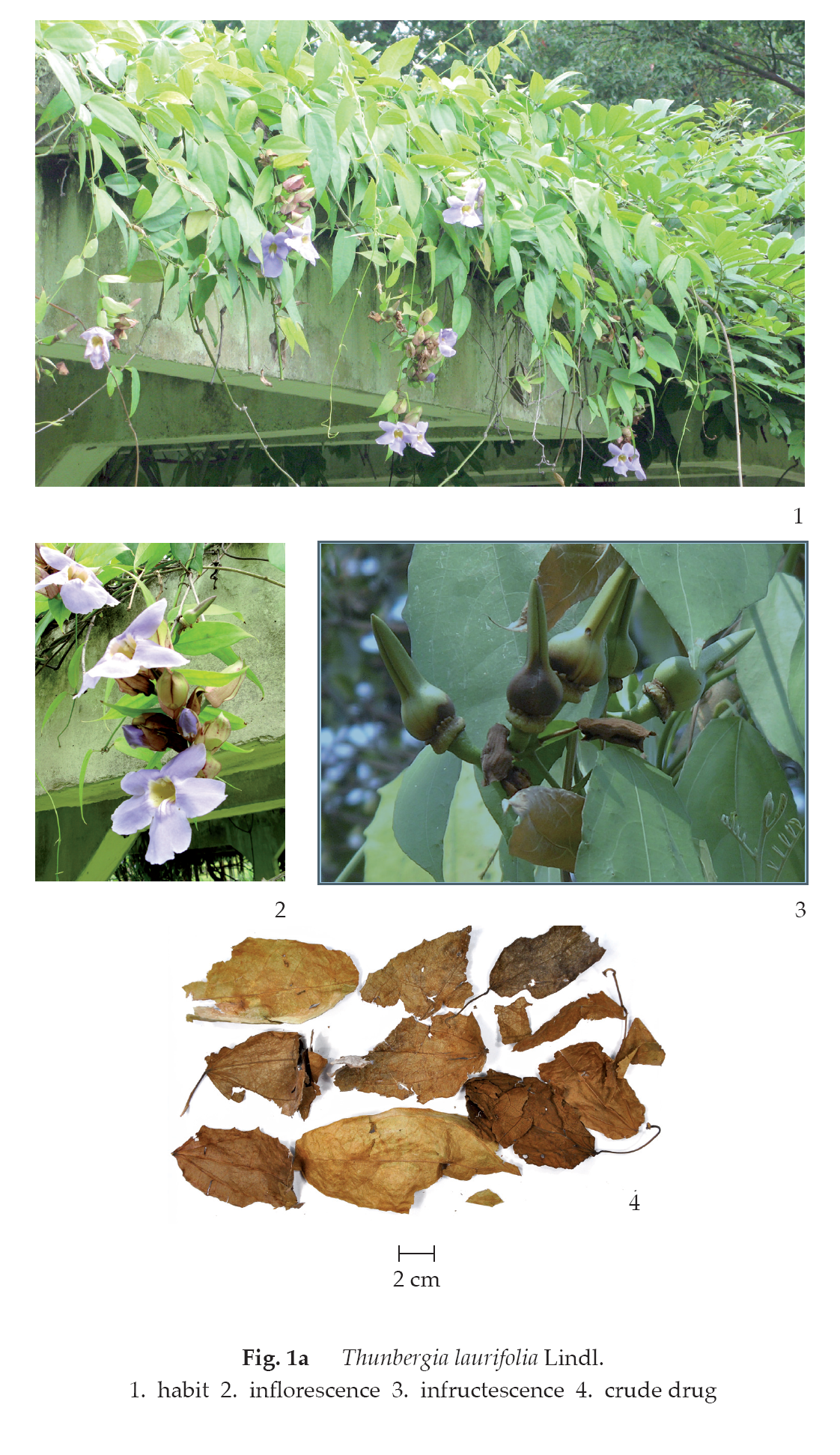
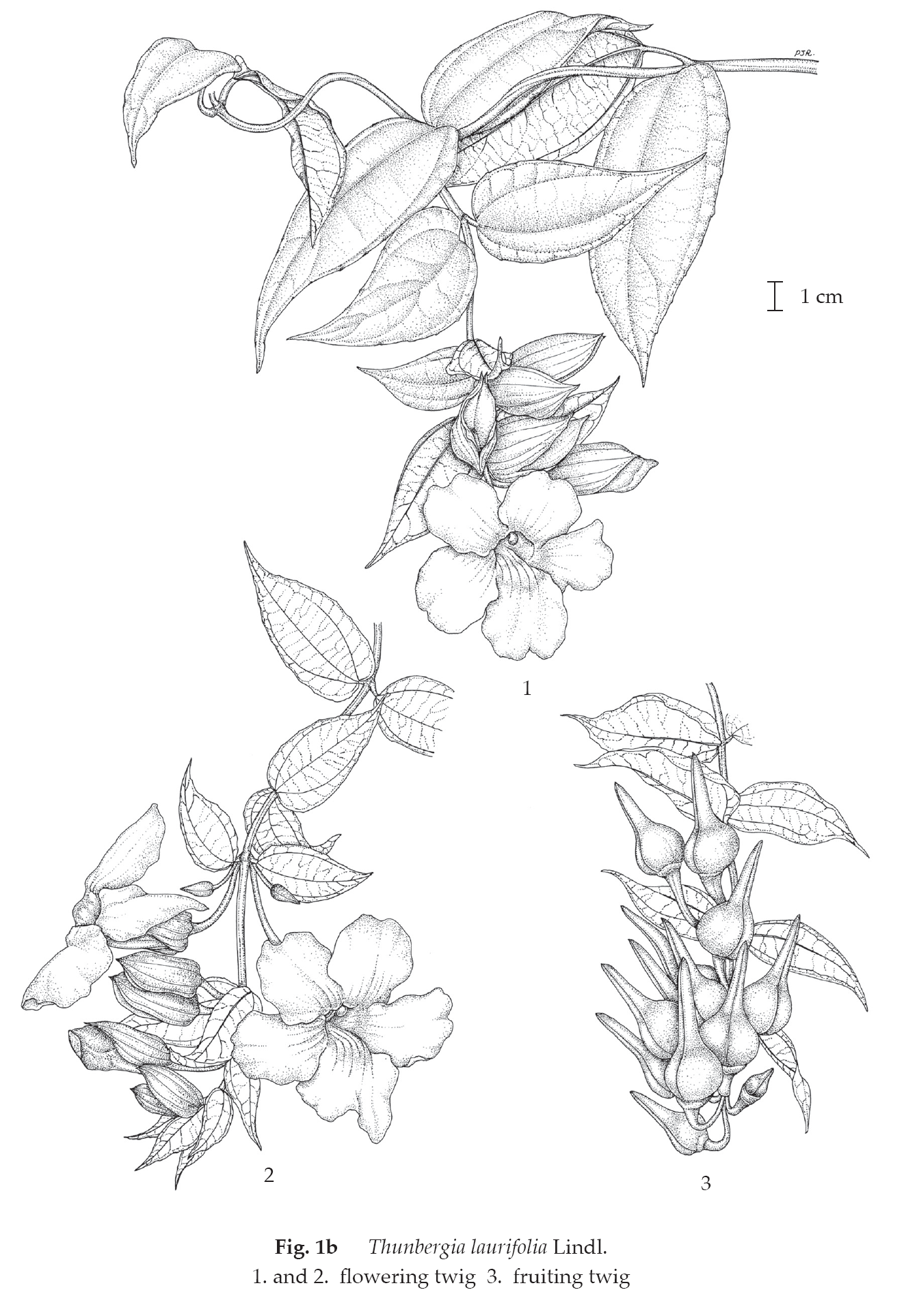
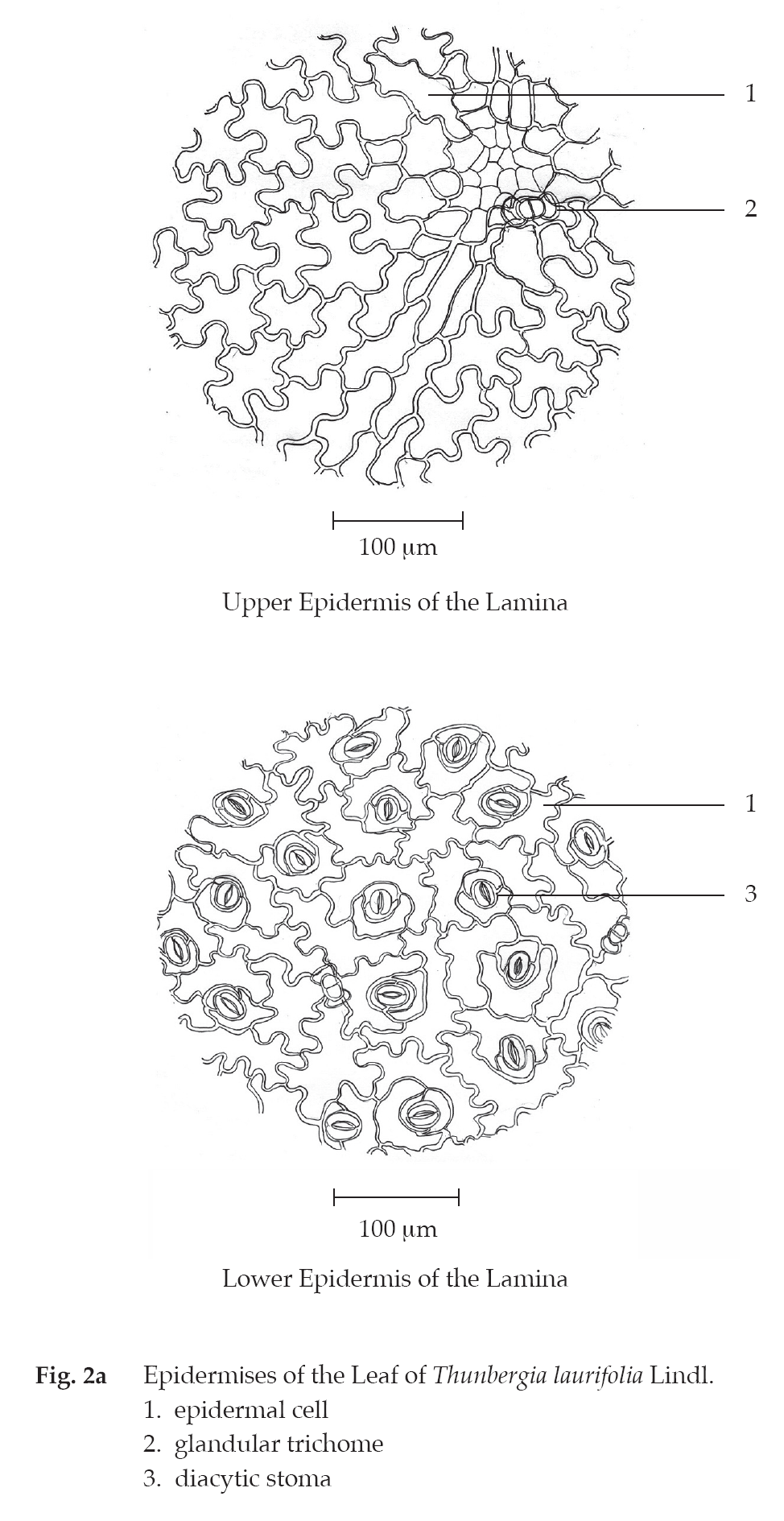
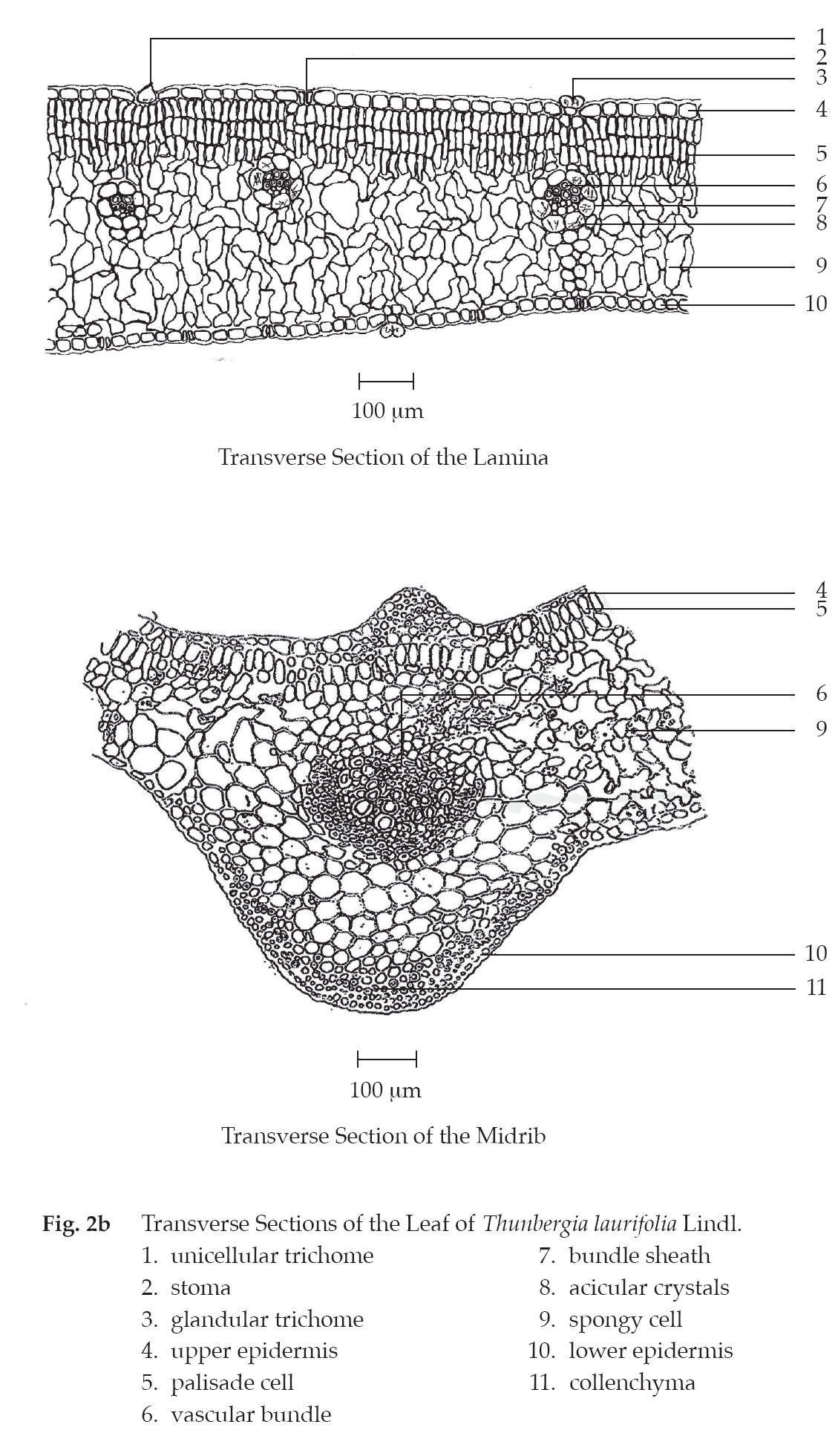
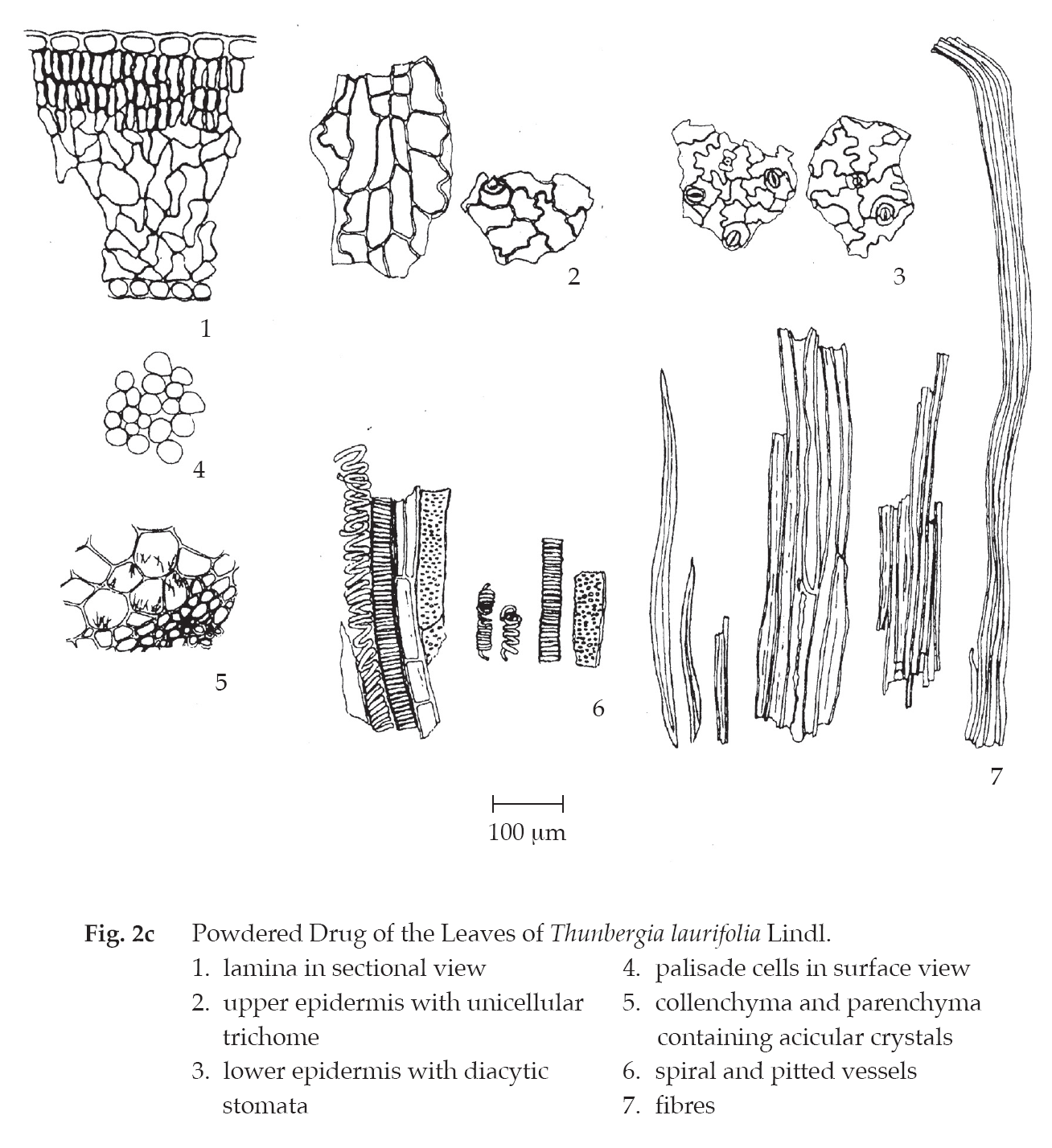
Warning Concomitant use with other drugs should be avoided since it may increase the excretion of the other drugs.
Additional information Ethnomedically, it has been used orally as a first-aid detoxificant. A use of 10 to 15 fresh or dried partially mature leaves, ground with sufficient amount of Nam Sao Khao (water washings from uncooked rice) or water, and squeezed to obtain about one tablespoonful of the extract, is suggested.
Packging and storage Blue Thunbergia Leaf shall be kept in well-closed containers, protected from light, and stored in a dry place.
Identification
A. Reflux 200 mg of the sample, in powder, with 10 mL of chloroform for 15 minutes and filter. Evaporate 2 mL of the filtrate to dryness in a test-tube. Dissolve the residue in 1 mL of acetic anhydride, cautiously add 1 mL of sulfuric acid to form two layers: a reddish brown colour forms at the zone of contact and the upper layer is green.
B. Heat 200 mg of the sample, in powder, with 10 mL of water in a water-bath for 10 minutes and filter. To 2 mL of the filtrate, add a few drops of iron(III) chloride TS: a greenish blue colour with precipitate is produced.
C. Carry out the test as described in the “Thin-Layer Chromatography” (Appendix 3.1), using silica gel G as the coating substance and a mixture of 70 volumes of chloroform, 30 volumes of methanol and 5 volumes of formic acid as the mobile phase and allowing the solvent front to ascend 10 cm above the line of application. Apply separately to the plate as bands of 8 mm, 8 μL of solution (A) and 3 μL of solution (B). Prepare solution (A) by refluxing 500 mg of the sample, in powder, with 25 mL of water for 30 minutes, filtering and evaporating to dryness. Dissolve the residue in 5 mL of a 50 per cent v/v solution of methanol. For solution (B), dissolve 1 mg of caffeic acid in 5 mL of a 50 per cent v/v solution of methanol. After removal of the plate, allow it to dry in air. Heat the plate at 80° for 10 minutes and then spray with natural products (NP) TS while the plate is still warm. Subsequently spray the plate with polyethyleneglycol (PEG) TS and observe the colours of the bands under ultraviolet light (366 nm) through the cut-off filter within 5 to 15 minutes. The chromatogram obtained from solution (A) shows an intense blue fluorescent band (hRf value 83 to 90) corresponding to the caffeic acid band from solution (B). Several fluorescent bands of different colours also appear (Table 1); see also Fig. 3.
Table 1 hRf Values of Components in Water Extract of the Leaves of Thunbergia laurifolia Lindl.
| Band | hRf Value | Detection |
| NP/PEG TS and UV 366 | ||
| 1 2 3 4 5 6 7 8 9* 10 |
6-8 10-13 16-19 23-28 30-33 33-40 49-57 69-78 83-90 91-93 |
light blue orangish brown light blue light blue orangish brown orangish brown blue intense blue intense blue blue |
*caffeic acid
Loss on drying Not more than 9.0 per cent w/w after drying at 105° to constant weight (Appendix 4.15).
Foreign matter Not more than 2.0 per cent w/w (Appendix 7.2).
Acid-insoluble ash Not more than 11.0 per cent w/w (Appendix 7.6).
Total ash Not more than 23.0 per cent w/w (Appendix 7.7).
Ethanol-soluble extractive Not less than 5.0 per cent w/w (Appendix 7.12).
Water-soluble extractive Not less than 14.0 per cent w/w (Appendix 7.12).
